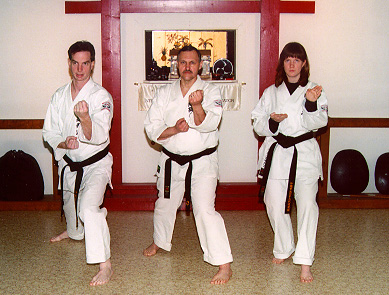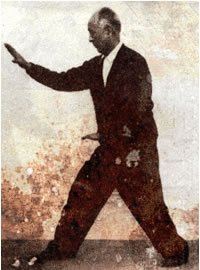Seisan - the Universal Kata?
It is known that a version of Seisan was taught in Naha by Seisho Aragaki as early as 1867. Moreover the Shuri and Tomari te styles of karate (the “Shorin” schools) appear to have taught a version of Seisan even before this.
Seisan is presently taught in all Goju-ryu schools, in Ryuei-Ryu, in Tou’on-ryu and Uechi-ryu (the "Naha te" schools). Although the Uechi-ryu version is significantly different from the other Naha te schools in the second half, the first half is clearly identifiable as being from the same source. As with Sanchin, Seisan is said to have been performed originally with open hands (which is still the case in the Uechi-ryu kata).
Seisan is also still common to all systems of Shorin schools, truly warranting its status as "the universal kata". At first glance the Shorin versions of Seisan appear to be completely different to those of the Naha te schools, however a closer analysis reveals that they too are related, albeit distantly.
Goju seisan - as performed by me in 1993
Traditionally it has been said that the Goju-ryu version of Seisan contains the beginning and the end of the "ancestral form", while the Shorin contains the middle. In this regard it is interesting to note that the Uechi-ryu version (which begins in a manner similar to the Goju form) features in its "middle" techniques and an embusen similar to those of the Shorin version. Compare the goju version with the ryuei ryu version:
Ryuei Ryu version performed by Sakamoto Sensei
Shorin seisan as performed by Howard Moring
See also Kyan style seisan here: http://www.youtube.com/watch?v=XR-msF9LpJM. Note carefully the "stomping" technique before the turn, highly reminiscent of tou'on ryu's version of the kata.
All of this poses the interesting question of whether the Uechi version is perhaps closer in some respects to the "original" Fujian version than any other Okinawan kata, or whether it reflects a "combination" of both forms by Kanbun Uechi.
Uechi seisan as performed by Kanei Uechi
The video below illustrates a technique from uechi ryu known as "ryuken". It is a technique that features in the uechi ryu seisan, but is also an application of the naha te versions. Consider the movement in the gif below and the video of ryuken as an application:

A technique that can be applied as ryuken in goju seisan (it corresponds to the same place where uechi ryu perform ryuken)
Ryuken in seisan kata
The closest present day "relative" of Seisan on the Chinese mainland would appear to be Yong Chun's "Shr san tai bau" form (which translates as "13 treasures" ). Some have argued that this kata might be the "ancestral" form of all the Okinawan Seisans, however a more likely scenario is that it is a "cousin" form - ie. it shares a common ancestry with the Okinawan versions. Again, the Uechi version would appear to be its closest Okinawan counterpart.
 My friend Martin Watts performs san shr tai bau - note his sanzhan stance (to download the form see http://www.fujianbaihe.com/fujianbaihe/main.html).
My friend Martin Watts performs san shr tai bau - note his sanzhan stance (to download the form see http://www.fujianbaihe.com/fujianbaihe/main.html).Seisan is most notable for its use, in some schools, of a stance known as "Seisan dachi" in place of sanchin. Seisan In some karate schools seisan dachi resembles the Yong Chun san zhan stance. In others (eg. IOGKF/Jundokan) it takes the form similar to Xingyi's "san ti" posture.
 Seisan dachi in Shorin karate (middle person) cf. Yong Chun's sanzhan - image from www.ikkf.org/
Seisan dachi in Shorin karate (middle person) cf. Yong Chun's sanzhan - image from www.ikkf.org/ Chen Pan-Ling demonstrates san ti shi posture from xingyiquan - picture from www.yizongbagua.com/
Chen Pan-Ling demonstrates san ti shi posture from xingyiquan - picture from www.yizongbagua.com/The potential link to Xingyi is not to be lightly dismissed as many of the moves (in particular the double block advancing forward after the first turn) are highly reminiscent of Xingyi's "pi quan" in feel and application.
 (The IOGKF seisan dachi as performed by Higaonna Morio - note the similarity to the stance in xingyi's san ti posture above.)
(The IOGKF seisan dachi as performed by Higaonna Morio - note the similarity to the stance in xingyi's san ti posture above.)Copyright © 2008 Dejan Djurdjevic



Comments
Post a Comment